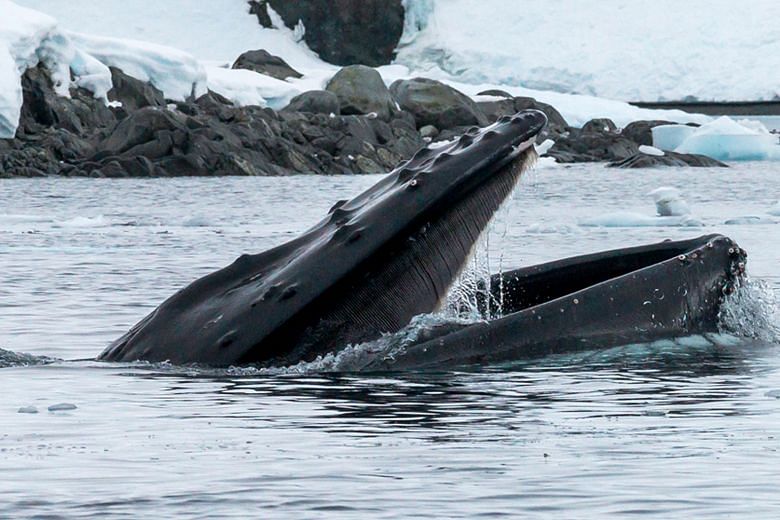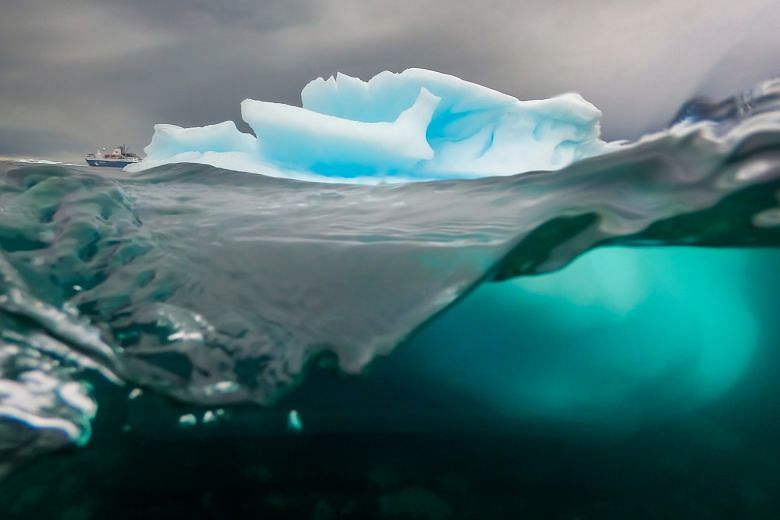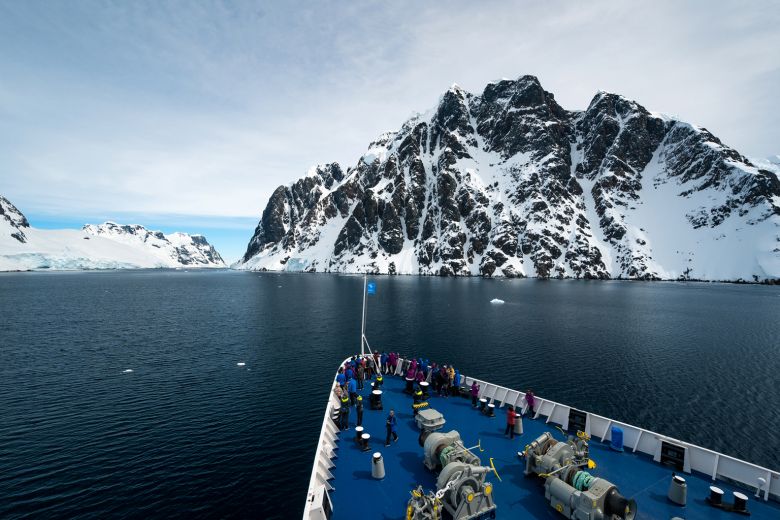To the end of the earth: Antarctica's raw, icy beauty and amazing wildlife
To see Antarctica up close is to be spellbound by the continent's raw, icy beauty and be captivated by its amazing wildlife
Sign up now: Get ST's newsletters delivered to your inbox
Chang Ai-Lien
Follow topic:
There are some places in this world where you should leave nothing behind, not even your footprint.
The great ice desert at the end of the earth is one of them.
There is life yet in this desolate white wilderness, just not of the human kind.
Penguins are king in Antarctica, gathering en masse to breed, the males carefully selecting small rocks to present to their love.
And when a careless tourist leaves a deep imprint in the snow, it could become a deathtrap for one of these endearing birds, if they are unable to scramble out.
As visitor numbers grow in this far-flung spot owned by no man, care is taken to leave nature undisturbed.
This was the case during Dynasty Travel's inaugural Antarctica Expedition Cruise, which sailed on Nov 21 last year with about 200 Singaporeans on board.
-
GETTING THERE
My 16-day trip, organised by Dynasty Travel (dynasty travel. com.sg), was the first Singapore-chartered cruise to Antarctica and worth almost $20,000.
I flew on Turkish Airlines (turkish airlines.com) to Buenos Aires in Argentina via Istanbul. Then I took a domestic flight to Ushuaia, the southernmost city in South America where many Antarctic cruises set off.
Dynasty Travel had chartered the Ocean Atlantic, operated by Albatros Expeditions, an ice-class vessel and one of the strongest that sail the oceans.
From Ushuaia, it took less than two days to cross the Drake Passage to the Antarctic Peninsula - infamous for being one of the roughest waterways on earth.
Lady Luck was smiling because the sea was as calm as glass and the seasick bags lining the handrails all over the boat remained untouched. We made such good time that we arrived early and were able to do an extra trip on land to see our first of thousands of penguins.
There were eight more landings over the next four days, on top of excursions on the small inflatable Zodiacs, where we got close to wildlife.
Expeditions are done only during the austral summer months between November and March, when the sea ice opens up just enough to allow passage for ships.
Dynasty's expedition to Antarctica, which set sail in November last year with about 200 Singaporeans on board, was led by the travel agency's chairman Perry Neo, who also made sure that their meals were peppered with local favourites such as bak kut teh and suckling pig.
Specialists on board took passengers out and gave in-depth explanations of icebergs, rock formations and wildlife, in English and Mandarin.
This year, Dynasty Travel has launched a trip to the other end of the globe. Its special charter to the Arctic - the Svalbard Expedition Cruise - departs in July. Check out special deals to Antarctica and the Arctic at the Dynasty Travel Celebration Fair today at Basement 4 Atrium, Ion Orchard, from 11am to 8pm.
For more information, call 6532-3833 or e-mail enquiries@dynastytravel.com.sg
Chang Ai-Lien
During the 10-day cruise, staff on the ice-class vessel Ocean Atlantic operated by Albatros Expeditions take pains to highlight to visitors how they should behave during our short forays on land.
When humans and penguins cross paths, for one, penguins have the right of way. Visitors must not stray from the paths laid out and marked with triangular flags and not a single pebble or other "souvenir" can be collected.
FIFTY SHADES OF ICE
What a place to leave untouched.
One where the ice crackles in the sea, glaciers calve with a thunderous roar and black mountains rise skyward cloaked in mantles of snow.
The ice is not just white, but every shade of blue, from pale aquamarine to deep sapphire. There are icebergs striped in black and brown or tinged with green or pink, and others clear as glass, all their air pressed out over the years.
They are works of art sculpted by the wind and the sea, changing form before our eyes as they melt and crack.
The splendour of the landscape is rivalled only by the charm of its wildlife.
Patches of pinkish brown amid the snowy landscape are the calling card of penguin colonies, the area stained by droppings that get their colour from a diet of krill.
Penguins get stained too and their brilliant white tummies turn brown, so they take to the sea to get the dirt off, flapping their wings enthusiastically and making joyful little jumps above the waves.
We see two penguin species - gentoos with their flamboyant orange beaks and chinstraps sporting a delicate black line under their heads - busy courting, mating, arguing and laying eggs early in the summer season, the only time when Antarctica is hospitable enough for cruise ships.
Just watching penguins going about their business is enough to make you smile, as they waddle along penguin highways created by countless birds marching along the same path, wings stretched behind them for balance.
These birds leave their speed and agility in the water. On land, they stumble often and fall on their front, look around as if to say 'I meant to do that' and then resort to simply sliding along the snow on their bellies for a while.
An unwelcome intruder in their midst and the cause of much commotion is the ever-present skua, a brown predatory seabird which is an aerial acrobat and expert penguin egg snatcher.
A WHALE OF A TIME
Then there are the seals, basking their glossy Rubenesque bodies on the ice without a care in the world.
Two crabeater seals seem unaware of their peril when a pod of killer whales arrives, spy-hopping or popping their heads above water to survey their potential meal.
But perhaps the passing ship disturbs the pod, and the six orcas swim away, a neat row of dorsal fins showing above the surface before they disappear altogether, leaving the seals to their stretching, scratching and sunning.
Then one night, as the setting sun turns the sea and sky a brilliant shade of tangerine, two seals surface in unison near the ship's bow, to the delight of photographers who have turned up to capture the sunset.
They seem equally fascinated by us and the two heads bob up again for another look - straight at the humans - before submerging beneath the waves.
No trip to Antarctica would be complete without whales - the Southern Ocean is a critical habitat for 80 per cent of the world's large whale species. They can be spotted by those with the patience to train their eyes on the sea.

One night, we observe dozens of the behemoths surfacing with a puff of their blowholes - and then the silhouette of their tails as they return to the depths.
Another day, a young humpback whale begins feeding just metres from our inflatable Zodiac boat, close enough for us to count the grooves on its white throat as it sieves the water for krill.
The weather is kind during the cruise, with mostly sunny days and endlessly blue skies and the occasional dusting of snow. The only time we have a taste of how quickly things can change is when we make the trip to Deception Island, the caldera of an active volcano near the tip of the Antarctic Peninsula.
As we walk inland the wind picks up from nothing, whipping sand against our faces and, within minutes, begins to approach safety limits. The sea turns increasingly choppy and we make it back to the ship in the nick of time, reminded of just how unpredictable Mother Nature can be.
LEAP OF FAITH
One of the optional activities on the cruise is the chance to jump into the sea.
Taking a plunge into freezing water is not my idea of fun. But staff member Jamie Watts puts things in perspective when he recounts how a 97-year-old on a previous trip insisted on doing the "polar plunge" even though he had fallen in the snow and battered his face the day before. He made it with no incident, fulfilling a boyhood dream in the process.
"If you do it, you may regret it, but if you don't, you'll definitely regret it," says the marine ecologist.
So, with his words echoing in my head, I jump off the side of the ship into those frigid waters, and even take a few extra seconds to swim around and peer into the crystal-clear depths.

The verdict - 1.5 deg C water is a shock to the system, but the experience is a reminder of what you can do if you put your mind to it.
About one in five people take the plunge that day, emerging teeth chattering, shaking and elated from the experience.
DOING OUR PART
To visit Antarctica is to fall under its spell and to love this wild end of the earth which belongs to no one, yet deserves to be cherished by all.
Many yearn to see it before, they fear, it is damaged beyond hope or recognition.
Many of the more than 1,200 people who wrote in to The Sunday Times for the chance to win this free trip to Antarctica had said that they wanted to see the continent before it melted away.
Signs of this are not apparent to a first-timer like me, awestruck by the icebergs and towering ice-capped mountains.
But the science says otherwise.
Some researchers believe that Antarctica is already approaching a tipping point which would result in a catastrophic rise in sea level.But it is not too late to reverse this yet.

The fate of the whales offers some hope. Their populations were decimated by commercial whaling in the 1900s, with many species teetering on the brink of extinction. But an international ban in 1986 has seen some species making a comeback.
The same can happen with climate change, but only if governments, businesses and individuals take urgent steps to prevent it from getting much worse.
If not, visitors to the great continent will not need to worry about covering up their icy imprints.
There won't be any to make.
• The writer and Multimedia Correspondent Ashleigh Sim were hosted by Dynasty Travel and Turkish Airlines.

